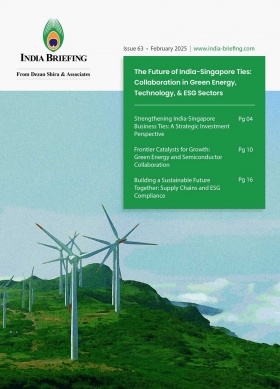New Financial Rules in India Effective July 1, 2025: What Businesses Need to Know
Starting July 1, 2025, a range of new financial rules will come into effect, many of which may influence your finances either directly or indirectly. From GST return filing to extended ITR deadlines, being aware of these updates in advance can help you stay prepared and avoid potential disruptions.
India is rolling out a series of important financial rules effective July 1, 2025, that will directly impact businesses and individual taxpayers. These updates aim to enhance digital transparency, improve consumer convenience, and strengthen tax compliance.
A major aspect of the changes pertains to businesses registered under the Goods and Services Tax (GST) regime, which will now be subject to stricter compliance requirements.
India Briefing outlines key updates businesses and taxpayers should prepare for.
CBIC extends GSTR-3B filing deadline for Mumbai region
The CBIC has announced an extension of the due date for filing Form GSTR-3B for July 2025. Through Notification No. 12/2025–Central Tax, issued on August 20, 2025, the deadline has been extended to August 27, 2025. GSTR-3B is a self-declared summary GST return filed on the 20th of every month (quarterly for the QRMP scheme).
The decision was taken in view of adverse weather conditions that caused disruptions in parts of the Mumbai region. The extension applies to registered taxpayers whose principal place of business is located in the following districts of Maharashtra:
- Mumbai City
- Mumbai Suburban
- Thane
- Raigad
- Palghar
Taxpayers in these districts, who are required to furnish returns under Section 39(1) read with Rule 61(1)(i) of the Central Goods and Services Tax (CGST) Rules, 2017, can avail themselves of the extended deadline. The CBIC has advised them to complete their filings by August 27 to avoid late fees and penalties.
GST return filing rules tightened for businesses
Starting July 1, 2025, GSTR-3B will no longer be editable after filing. Once submitted, taxpayers will not have the option to amend or revise any part of the return. This change is expected to have a considerable impact on how businesses approach GST compliance.
GSTR-3B is a monthly summary return form that businesses registered under the GST system in India must file. It contains details such as outward and inward supplies, input tax credit (ITC) claims, and the net tax liability to be paid to the central government. As a key compliance document, GSTR-3B ensures that tax liabilities are settled promptly and serves as a tool for monitoring monthly GST collections.
Any mistake in tax calculations, reporting of supplies, or ITC claims will become permanent for that tax period, potentially resulting in mismatches, missed credits, or payment discrepancies. For businesses, this means a higher risk of penalties, increased scrutiny from tax authorities, and the possibility of legal complications arising from inaccurate returns.
In response, businesses will need to adopt a more rigorous approach to data verification before filing. This includes thorough internal checks, reconciliation of invoices and credit notes, and ensuring all figures are aligned with records maintained in enterprise systems and on the GST portal. Companies may seek support from tax professionals to reduce the likelihood of filing errors.
Three-year time limit introduced for filing past GST returns
Effective July 1, 2025, taxpayers in India will no longer be permitted to file GST returns if more than three years have elapsed since the original due date. This restriction applies across key GST return forms, including GSTR-1 (outward supplies), GSTR-3B (summary return), GSTR-4 (composition scheme return), and others. The rule aims to reinforce timely compliance and prevent misuse of the return filing system.
|
GST form |
Description |
The earliest period barred from filing |
|
GSTR-1/IFF |
The Invoice Furnishing Facility (IFF) allows quarterly GSTR-1 filers under the QRMP scheme to upload business-to-business invoices monthly. |
June 2022 |
|
GSTR-1Q |
Monthly or quarterly return summarizing outward supplies (sales). |
April–June 2022 |
|
GSTR-3B |
Monthly summary return detailing sales, ITC claims, tax liabilities, and refunds. |
June 2022 |
|
GSTR-4 |
Annual return for composition scheme taxpayers from FY 2019–20 onwards, detailing outward/inward supplies and reverse charge transactions. |
FY 2021–22 |
|
GSTR-5 |
Return for non-resident taxable people, due within seven days post-registration expiry. |
June 2022 |
|
GSTR-6 |
Monthly return filed by Input Service Distributors (ISD) to declare and distribute ITC. |
June 2022 |
|
GSTR-7 |
Monthly return for taxpayers deducting tax deducted at source (TDS) under GST, including TDS details and refunds. |
June 2022 |
|
GSTR-8 |
Monthly return filed by e-commerce operators registered under GST. |
June 2022 |
|
GSTR-9/9C |
GSTR-9 is the annual return summary of supplies, ITC, and tax paid; GSTR-9C is a certified reconciliation for businesses with turnover above INR 50 million (US$583,021). |
FY 2020–21 |
Source: Goods and Services Tax Network (GSTN)
Businesses must ensure that tax return filings are completed correctly and within the stipulated timelines. Delays or errors in filing could now lead to permanent record lock-ins or potential penalties.
It is recommended that taxpayers implement internal checks or seek professional assistance to avoid costly filing mistakes.
Income Tax Return (ITR) deadline extended to September 15
In a relief to salaried individuals and small taxpayers in the country, the deadline to file ITR for Assessment Year (AY) 2025–26 has been extended from July 31 to September 15, 2025. Tax experts advise early filing to avoid last-minute IT department portal slowdowns. Filing early also allows for quicker resolution of refund or verification issues.
Aadhaar mandatory for new PAN cards
Starting July 1, 2025, individuals applying for a new Permanent Account Number (PAN) card must possess an Aadhaar card. Aadhaar-based authentication will be mandatory for the application process. This move aligns with India’s broader push toward digital governance and aims to enhance transparency and compliance in the tax system.
Previously, a valid ID and birth certificate were sufficient to obtain a PAN. However, Aadhaar is now mandatory for all new PAN applications.
Earlier in April 2025, the Central Board of Direct Taxes (CBDT) clarified that PAN cards issued on or before October 1, 2024, using an Aadhaar enrolment number can be linked to Aadhaar until the final deadline of December 31, 2025. Failure to complete the linkage by then will render such PAN cards inoperative.
ALSO READ: India’s PAN 2.0 Project: All You Need to Know
Conclusion
From income tax to GSTR filing, new financial rules bring a wave of reforms designed to boost transparency, improve user experience, and tighten compliance. Whether you’re a taxpayer or a business owner in India, staying informed and adapting early can help avoid penalties and ensure smooth transitions.
(US$1 = INR 85.76)
(This article was originally published on June 30, 2025. It was updated on August 21, 2025.)
About Us
India Briefing is one of five regional publications under the Asia Briefing brand. It is supported by Dezan Shira & Associates, a pan-Asia, multi-disciplinary professional services firm that assists foreign investors throughout Asia, including through offices in Delhi, Mumbai, and Bengaluru in India. Readers may write to india@dezshira.com for support on doing business in India. For a complimentary subscription to India Briefing’s content products, please click here.
Dezan Shira & Associates also maintains offices or has alliance partners assisting foreign investors in China, Hong Kong SAR, Dubai (UAE), Indonesia, Singapore, Vietnam, Philippines, Malaysia, Thailand, Bangladesh, Italy, Germany, the United States, and Australia.
- Previous Article India’s FTA Network: Updates in 2025
- Next Article Winners and Losers: India’s Online Gaming Bill Elevates E-Sports, Bans Real-Money Gaming








